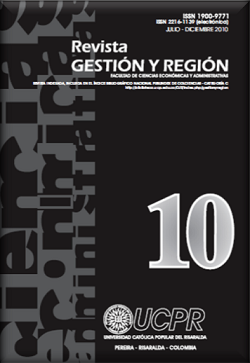Unemployment Rate Convergence in Colombian Regions, 2001–2010
Keywords:
Convergence, unemployment, regional economyAbstract
Given the importance of studying regional unemployment, the purpose of thisarticle is to present the results of contrasting the hypothesis of the existence ofcommon trends and processes of convergence between the rates of unemploymentin Colombia in the period 2001–2010. To this end, the article uses cointegrationmethodology and the monthly series of DANE surveys of households. The articleconcludes that the series of unemployment rates in the metropolitan areas maintainsa stable long-term relation between them. However, it is evident that the relation isnot rigid, because employment variables are subject to exogenous shocks thattemporarily alter its equilibrium path.
References
Antolín, P. (1995). Movilidad laboral, flujos de desempleo, vacantes y comportamiento en la búsqueda de empleo en el mercado de trabajo español. Moneda y Crédito, 201, 49-86.
Arango, L. y Posada, C. (2001). El desempleo en Colombia. Borradores de Economía, 176. Bogotá: Banco de la República,
Aviles, A., Games, C. y Torres, J. (1997). Convergencia real de Andalucía: Un análisis de cointegración del mercado de trabajo. Universidad de Málaga. Estudios regionales, 47, 15-36.
Aznar, M. y Vinas, G. (2005). Geografía Económica y Economías de Aglomeración: Análisis para la industria manufacturera en México para 1998. Tesis de Licenciatura en Economía, Universidad de las Américas. Méjico: Puebla.
Barro, R. (1991): “Economic growth in a cross section of countries”, Quarterly Journal of Economics, 106, 407-443.
Barro, R. & Sala-i-martin, X. (1992). “Convergence”. Journal of Political Economy, 100, 223-251.
Basile, R. & De Benedictis, L. (2004). Regional unemployment and productivity in Europe and the US. Luiss lab on European economics working document, 8,
Bayer, C. & Juessen, F. (2004). Convergence in West German Regional unemployment rates. European University Institute. University of Dortmund. Mimeo.
Berguer, M. & Glenn, C. (1992). Mobility and Destination in Migration Decisions: The roles of Earnings, Quality Life and Housing Prices. Journal of Housing Economics, 2(1), 37-59.
Bernard, A. & Durlauf, S. (1996): “Interpreting tests of the convergence hypothesis”, Journal of Econometrics, 71, 161-173.
Bianchi, M. & Zoega, G. (1997). Challenges facing natural rate theory. European Economic review, 41, 535-547.
Blanchard, O. y Summers, L. (1989). Hysteresis in unemployment. Massachusetts: Harvard University press.
Byers, J. (1991). Testing for Common Trends in Regional Unemployment. Applied Economics, 23, 1087-1092.
Clemente, J., Montanes, A., Reyes, M. (1998). Testing for a unit root in variables with a double change in the mean. Economics Letters, 59, 175-182.
De Espínola, J. y Fernández, M. (2001). El desempleo en Castilla y León y los desajustes en los mercados de trabajo Europeos. La Rioja: Universidad de la Rioja.
Dickey, D. & Fuller, W. (1979). Distribution of the Estimates for Autoregressive Time Series With Unit Root, Journal of the American Statistical Association, 74,. 427-431.
Doeringuer, P. & Piore, M. (1971). Los mercados internos de trabajo. En: L. Toharia (1983) (Compilador). El Mercado de trabajo: Teorías y aplicaciones. Madrid: Alianza Universidad textos. Pp. 341-368.
Doeringer, P. y Piore, M. J. (1985). Mercados internos de trabajo y análisis laboral. Madrid: Ministerio de trabajo y seguridad social.
Elhorst, J. (2003). “The mystery of regional unemployment differentials: theoretical and empirical explanations”. Journal of Economic Reviews, 17(5), 709-748.
Enders, W. (1995). Applied econometric time series. EE.UU: John Wiley & Sons.
Filiztekin, A. (2007). Regional unemployment in Turkey. Sabanci University. Papers in regional science, 88, 863-878.
Gabriel, S., Mathey, J. & Wascher, W. (1995). The Demise of California reconsidered: Interstate Migration over the Economic Cicle. Federal Reserve Bank of San Francisco Economic Review, 2,30-45.
Gabriel, S., Shack-Marquez, J. & Wascher, W. (1993). Does Migration Arbitrage Regional Labor Market Differentials? Regional Science and Urban Economics, 32(2), 211-233.
Gamarra, J. (2006). ¿Cómo se comportan las tasas de desempleo en siete ciudades Colombianas? Revista de Economía del Rosario, (2). Bogotá: Universidad del Rosario
Hall, R. (1979). A theory of the natural unemployment rate and the duration of unemployment. Journal of monetary economics, 5(2), 153 – 169.
Johansen, S. (1988). Statistical analysis of cointegrating vectors. Journal of Economic Dynamics and Control, 12, 231-254.
Karanassou, M. & Snower, D. (2000) Characteristics of Unemployment Dynamics: The Chain Reaction Approach. IZA Discussion papers, 205,
Klepfish, V. & Presman, N. (2007). Regional unemployment convergence in Israel. Bank of Israel, Reasearch department.
Kunz, M. (2009a). Disparities, persistence and dynamics of regional unemployment rates in Germany. Institute for employment research. Regensburg: University of Regensburg.
Kunz, M. (2009b). Sources for regional unemployment disparities in Germany: ¿Lagged adjustment processes, exogenous shocks or both? Institute for employment research. Regensburg: University of Regensburg.
Levin, A., Lin, C., Chu, C. (2002). Unit Root Tests in Panel Data: Asymptotic and Finite Sample Properties. Journal of Econometrics, 108(1),1-24.
Llorente, R.(2004). Convergencia o divergencia del desempleo en el entorno europeo. Tesis de doctorado. Universidad de Alcalá.
Llorente, R.(2005). La convergencia entre las tasas de desempleo europeas. Revista de Economía Laboral, 2(1),1-30.
Marston, S. (1985). “Two views of the geographic distribution of unemployment”. The Quarterly Journal of Economics, 100(1), 57-79.
Moral de Blas, A. (2003). Un análisis de la convergencia de las tasas de paro regionales en España: 1977–2000. Tesis de doctorado. Universidad de Valladolid.

